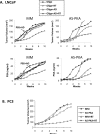PKA knockdown enhances cell killing in response to radiation and androgen deprivation
- PMID: 20960462
- PMCID: PMC3391603
- DOI: 10.1002/ijc.25634
PKA knockdown enhances cell killing in response to radiation and androgen deprivation
Abstract
The therapeutic efficacy of Gem®231, a second generation antisense molecule targeted to the RIα subunit of PKA(RIα) (AS-PKA), administered in combination with androgen deprivation (AD) and radiation therapy (RT), was examined in androgen sensitive (LNCaP) and insensitive (PC3) cell lines. Apoptosis was assayed by Caspase 3 + 7 activity and Annexin V binding. AS-PKA significantly increased apoptosis in vitro from RT (both lines), with further increases in LNCaP cells grown in AD medium. In LNCaP cells, AD increased phosphorylated mitogen activated protein-kinase (pMAPK), which was reduced by AS-PKA relative to the mismatch (MM) controls. AS-PKA also reduced pMAPK levels in PC3 cells. Cell death was measured by clonogenic survival assays. In vivo, LNCaP cells were grown orthotopically in nude mice. Tumor kinetics were measured by magnetic resonance imaging and serum prostate-specific antigen. PC3 cells were grown subcutaneously and tumor volume assessed by caliper measurements. In PC3 xenografts, AS-PKA caused a significant increase in tumor doubling time relative to MM controls as a monotherapy or in combination with RT. In orthotopic LNCaP tumors, AS-PKA was ineffective as a monotherapy; however, it caused a statistically significant increase in tumor doubling time relative to MM controls when used in combination with AD, with or without RT. PKA(RIα) levels in tumors were quantified via immunohistochemical (IHC) staining and image analysis. IHC measurements in LNCaP cells exhibited that AS-PKA reduced PKA(RIα) levels in vivo. We demonstrate for the first time that AS-PKA enhances cell killing androgen sensitive prostate cancer cells to AD ± RT and androgen insensitive cells to RT.
Copyright © 2010 UICC.
Figures


Similar articles
-
Antisense MDM2 enhances the response of androgen insensitive human prostate cancer cells to androgen deprivation in vitro and in vivo.Prostate. 2008 May 1;68(6):599-609. doi: 10.1002/pros.20731. Prostate. 2008. PMID: 18196567 Free PMC article.
-
Antisense MDM2 sensitizes prostate cancer cells to androgen deprivation, radiation, and the combination.Int J Radiat Oncol Biol Phys. 2004 Feb 1;58(2):336-43. doi: 10.1016/j.ijrobp.2003.09.029. Int J Radiat Oncol Biol Phys. 2004. PMID: 14751501
-
Adenovirus E2F1 overexpression sensitizes LNCaP and PC3 prostate tumor cells to radiation in vivo.Int J Radiat Oncol Biol Phys. 2011 Feb 1;79(2):549-58. doi: 10.1016/j.ijrobp.2010.08.013. Int J Radiat Oncol Biol Phys. 2011. PMID: 21195876 Free PMC article.
-
Antisense-MDM2 sensitizes LNCaP prostate cancer cells to androgen deprivation, radiation, and the combination in vivo.Int J Radiat Oncol Biol Phys. 2007 Jul 15;68(4):1151-60. doi: 10.1016/j.ijrobp.2007.03.047. Int J Radiat Oncol Biol Phys. 2007. PMID: 17637390 Free PMC article.
-
Chemoprevention with protein kinase A RIalpha antisense in DMBA-mammary carcinogenesis.Ann N Y Acad Sci. 2005 Nov;1058:255-64. doi: 10.1196/annals.1359.038. Ann N Y Acad Sci. 2005. PMID: 16394142 Review.
Cited by
-
Ionizing radiation induces neuroendocrine differentiation of prostate cancer cells in vitro, in vivo and in prostate cancer patients.Am J Cancer Res. 2011;1(7):834-44. Epub 2011 Aug 18. Am J Cancer Res. 2011. PMID: 22016831 Free PMC article.
-
cAMP Signaling in Cancer: A PKA-CREB and EPAC-Centric Approach.Cells. 2022 Jun 24;11(13):2020. doi: 10.3390/cells11132020. Cells. 2022. PMID: 35805104 Free PMC article. Review.
-
Targeting protein kinase A in cancer therapy: an update.EXCLI J. 2014 Aug 18;13:843-55. eCollection 2014. EXCLI J. 2014. PMID: 26417307 Free PMC article. Review.
-
Enhanced inhibition of prostate tumor growth by dual targeting the androgen receptor and the regulatory subunit type iα of protein kinase a in vivo.Int J Mol Sci. 2013 Jun 4;14(6):11942-62. doi: 10.3390/ijms140611942. Int J Mol Sci. 2013. PMID: 23736698 Free PMC article.
-
Phenotypic characterization of prostate cancer LNCaP cells cultured within a bioengineered microenvironment.PLoS One. 2012;7(9):e40217. doi: 10.1371/journal.pone.0040217. Epub 2012 Sep 5. PLoS One. 2012. PMID: 22957009 Free PMC article.
References
-
- Pilepich MV, Winter K, John MJ, Mesic JB, Sause W, Rubin P, Lawton C, Machtay M, Grignon D. Phase III radiation therapy oncology group (RTOG) trial 86-10 of androgen deprivation adjuvant to definitive radiotherapy in locally advanced carcinoma of the prostate. Int J Radiat Oncol Biol Phys. 2001;50:1243–52. - PubMed
-
- D'Amico AV, Manola J, Loffredo M, Renshaw AA, DellaCroce A, Kantoff PW. 6-month androgen suppression plus radiation therapy vs radiation therapy alone for patients with clinically localized prostate cancer: a randomized controlled trial. Jama. 2004;292:821–7. - PubMed
-
- Denham JW, Steigler A, Lamb DS, Joseph D, Mameghan H, Turner S, Matthews J, Franklin I, Atkinson C, North J, Poulsen M, Christie D, Spry NA, Tai KH, Wynne C, Duchesne G, Kovacev O, D'Este C. Short-term androgen deprivation and radiotherapy for locally advanced prostate cancer: results from the Trans-Tasman Radiation Oncology Group 96.01 randomised controlled trial. Lancet Oncol. 2005;6:841–50. - PubMed
-
- Vance W, Tucker SL, de Crevoisier R, Kuban DA, Cheung MR. The predictive value of 2-year posttreatment biopsy after prostate cancer radiotherapy for eventual biochemical outcome. Int J Radiat Oncol Biol Phys. 2007;67:828–33. - PubMed
Publication types
MeSH terms
Substances
Grants and funding
LinkOut - more resources
Full Text Sources
Medical
Research Materials

